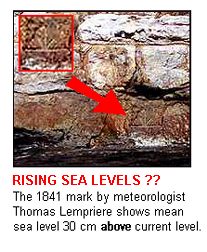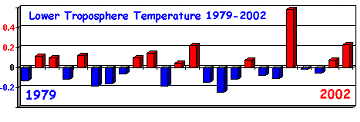|
EL NINO CAUSED BY SUN
-NOT GLOBAL WARMING
By Fintan Dunne,
Editor, GuluFuture.com
12th August 2002
PAGE
URL
http://www.gulufuture.com/future/weather02_z.htm
El Nino is back.
 World
weather is going crazy again. But it has little to do with global warming
caused by greenhouse gasses and plenty to do with variations in solar
activity. World
weather is going crazy again. But it has little to do with global warming
caused by greenhouse gasses and plenty to do with variations in solar
activity.
Indeed the entire concept of rising sea levels caused by melting ice caps
--may be only a storm of hype.
Back in 1841, famous Antarctic explorer Captain Sir James Clark Ross made
his mark on a little island near Port Arthur, Tasmania. That is, he literally
marked
the mean level of the tides on a sandstone cliff face. Incredibly,
that the mark is one inch above the current mean tide level today.
Greenhouse effect dissenter and former ship's officer in the British Merchant
Navy, John Daly trumpets
the mark to rubbish claims of melting polar ice caps.
"When we look at the Ross-Lempriere 1841 bench mark, one thing becomes
crystal clear: There has been no sea level rise this century - none at
all."
Media reports abound
of continued global warming. "World
Heads for Warmest Year Yet" enthused a recent Reuters report.
But many of the temperature readings are inaccurate, or compromised by
their location near urban centers, or based on downright misleading
reports. The year 1998 was warm -but temperatures have actually
gone down since then.
 Record
low temperatures hit the US Midwest and eastern states in May 2002, while
southeastern Australia had the coolest summer in decades. The famous Northwest
Passage has not opened this year and there is more sea ice than ever around
the Antarctic, trapping several ships. Recently, an icebreaker became
trapped
in the Antarctic ice for months --hardly evidence of global warming. Record
low temperatures hit the US Midwest and eastern states in May 2002, while
southeastern Australia had the coolest summer in decades. The famous Northwest
Passage has not opened this year and there is more sea ice than ever around
the Antarctic, trapping several ships. Recently, an icebreaker became
trapped
in the Antarctic ice for months --hardly evidence of global warming.
SO MUCH SCIENTIFIC HOT AIR
All the hype may have more to do with protecting the interests of the
global warming research industry and the political skins of the environmental
movement.
The much publicized global surface temperature measurements are completely
at variance with satellite measurements of the lower
troposphere. Furthermore, records of the continental US surface temperature
show the 1930's --not the '90's-- were the hottest years this century.

So, if greenhouse gasses are not driving temperatures to record levels
after all, what is behind the temperature variations and the El Nino/La
Nina effect?
To answer that, we must turn to a real climate forecaster. The
establishment pundits only "predicted" the current El Niņo cycle
when it was already underway. Dr. Theodor Landscheidt, using an analysis
of solar eruptions and solar motions, forecast a late 2002 El Niņo peak,
describing the process in
detail in January 1999.
He used sophisticated mathematical analysis to forecast the El Niņo reappearance
three years ahead --based on cycles of solar activity. This approach runs
counter to the official bias in favor of greenhouse gasses as the major
causative factor.
SOLAR POWERED WEATHER
 The
established judgments are based on the fact that the solar radiation changes
only by a fraction of a percent during the course of the 11-year sunspot
cycle. The
established judgments are based on the fact that the solar radiation changes
only by a fraction of a percent during the course of the 11-year sunspot
cycle.
But Landscheidt says that energetic flares, coronal mass ejections, eruptive
prominences and coronal holes have significant
effects on the solar wind.
"The total magnetic flux leaving the Sun, dragged out by the solar
wind, has risen by a factor of 2.3 since 1901," says Landscheidt.
"While concomitantly global temperature increased by about 0.6°C."
"The energy in the solar flux is transferred to the near-Earth environment
by magnetic reconnection and directly into the atmosphere by charged particles."
 Fangqun
Yu, of the Atmospheric Sciences Research Center at the State University
of New York-Albany, has shown that cosmic rays may have effects on the
cloudiness of the lower atmosphere. Cosmic rays are high speed particles
of either galactic or solar origin. The amount of cosmic rays falling
on the Earth varies depending on the "weather" conditions in
space and variations in solar activity. Fangqun
Yu, of the Atmospheric Sciences Research Center at the State University
of New York-Albany, has shown that cosmic rays may have effects on the
cloudiness of the lower atmosphere. Cosmic rays are high speed particles
of either galactic or solar origin. The amount of cosmic rays falling
on the Earth varies depending on the "weather" conditions in
space and variations in solar activity.
Yu's research indicated that the cosmic rays stimulate the production
of particles in the lower atmosphere which increase cloud density. Satellite
data shows a correlation between cosmic ray intensity and the fraction
of the Earth covered by low clouds. During the 20th century, periods when
the Earth has warmed have corresponded with decreases in cosmic ray intensity.
Height dependent differences can cause an increase of particles in the
lower troposphere and a decrease in the upper atmosphere. High clouds
generally reflect sunlight while lower clouds tend to retain surface energy.
"A systematic change in global cloud cover will change the atmospheric
heating profile," according to Yu.
DON'T RAIN ON THEIR PARADE
Cosmic ray induced cloud level changes could be the key mechanism connecting
solar and climate variability. That assessment indicates that the current
El Niņo effect is unlikely to approach the severity of the preceding cycles.
If that view is to prevail, it will entail the sudden ending of many careers
in a climate research field more akin to a business than a science. So,
next time you hear dire pronouncements about climate change, you can relax.
 You
will easily survive the oncoming storm of hype. You
will easily survive the oncoming storm of hype.
It's just business as usual.
EL NINO WEBSITES
John
Daly's Global Warming Views
Cosmic
Rays Solve Global Warming
El
Niņo Forecast Revisited
Solar
Activity Controls El Niņo and La Niņa
GuluFuture
HomePage
|

